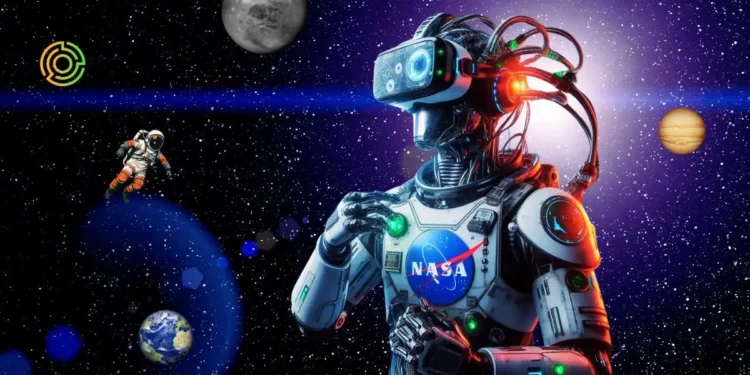In a groundbreaking move, NASA, the pioneering space agency, has embraced the cutting-edge technology of virtual reality (VR) headsets to revolutionize the design and training processes for its ambitious Moon-orbiting Gateway station project. This innovative approach not only signifies a remarkable leap forward in space exploration but also underscores the versatile applications of VR technology beyond conventional realms.
Unveiling the Future of Space Exploration with VR
NASA’s relentless pursuit of innovation has led to the integration of VR headsets in the design and training phases of its lunar space station Gateway. Spearheaded by astronauts Raja Chari and Nicole Mann, both veterans of SpaceX missions to the International Space Station, this visionary initiative promises to redefine the way astronauts prepare for and operate in space.
Astronauts at @NASA_Johnson are using virtual reality to explore Gateway. When they slip on their headsets, they're not just seeing the station—they're in it, meticulously surveying every detail and offering crucial insights on design and functionality. https://t.co/H3NaY7a7pR pic.twitter.com/haBKpw6JgG
— NASA's Gateway Program (@NASA_Gateway) April 9, 2024
Redefining Space Station Design
The utilization of VR headsets enables NASA engineers and astronauts to visualize and interact with the Gateway station in three-dimensional space, transcending the limitations of traditional two-dimensional models. This immersive experience facilitates real-time collaboration, allowing stakeholders to identify and address design complexities with unparalleled precision and efficiency.
Transformative Training Simulations
Beyond design, VR headsets serve as invaluable tools for astronaut training, simulating the challenging conditions of space travel with unparalleled realism. Through immersive simulations, astronauts can familiarize themselves with the layout and operation of the Gateway station, honing their skills and decision-making abilities in a safe yet dynamic environment.
The Technology Behind the Innovation
At the heart of this groundbreaking endeavor lies spatial computing technology, which seamlessly integrates computing capabilities with physical surroundings. VR headsets leverage this technology to provide users with a seamless three-dimensional viewing experience, enabling them to navigate virtual environments with unprecedented freedom and clarity.
Embracing HTC VIVE: A Game-Changer in VR Technology
NASA’s choice of the HTC VIVE VR headset underscores its commitment to leveraging state-of-the-art technology for space exploration. With a market price of $1,399, the HTC VIVE offers unparalleled fidelity and performance, making it the preferred choice for high-stakes applications such as space station design and astronaut training.
Shaping the Future of VR Technology
NASA’s pioneering use of VR headsets has far-reaching implications beyond the realm of space exploration. As major tech players like Meta and Apple enter the VR market with products like the Quest and Vision Pro, the potential for VR technology to revolutionize industries ranging from healthcare to education becomes increasingly apparent.
Expanding Applications Beyond Space Exploration
The adoption of VR headsets by NASA serves as a catalyst for innovation across diverse sectors. Major corporations like Walmart and Nike are already harnessing the power of VR technology to enhance consumer experiences and streamline employee training programs, signaling a paradigm shift in the way we interact with digital content.
Market Projections and Growth Opportunities
According to market research, the global market for augmented and virtual reality headsets is poised to exceed $25 billion by 2023, driven by increasing demand for immersive experiences across various industries. As VR technology continues to evolve and mature, opportunities for innovation and growth abound.
Looking Ahead: The Future of the Gateway Project
Despite the remarkable progress achieved thus far, NASA’s Gateway project faces challenges on its path to fruition. Reports suggest that the project’s scheduled launch for October 2025 may be extended to align with the launch of the Artemis IV mission in 2028, highlighting the complexities inherent in large-scale space endeavors.
In conclusion, NASA’s pioneering use of VR headsets for the design and training of its Moon-orbiting Gateway station represents a paradigm shift in space exploration. By embracing cutting-edge technology and pushing the boundaries of innovation, NASA continues to inspire awe and wonder as humanity ventures further into the cosmos.
FAQs
1. What is NASA’s Gateway Project?
NASA’s Gateway Project aims to establish a lunar space station, known as the Gateway, which will orbit around the Moon. It serves as a crucial outpost for astronauts conducting lunar missions and paves the way for future exploration of deep space.
2. How is NASA using VR headsets for the Gateway Project?
NASA is utilizing virtual reality (VR) headsets to facilitate the design and training processes for the Gateway Project. Astronauts and engineers can visualize and interact with the station in three-dimensional space, enabling more immersive collaboration and realistic simulations.
3. Why is NASA incorporating VR technology into its operations?
NASA sees VR technology as a game-changer for space exploration, offering unparalleled capabilities for design visualization and astronaut training. By embracing VR, NASA aims to enhance efficiency, safety, and effectiveness in all aspects of its missions.
4. Which VR headset is NASA using for the Gateway Project?
NASA has opted for the HTC VIVE VR headset for its Gateway Project endeavors. Renowned for its high fidelity and performance, the HTC VIVE enables astronauts and engineers to engage with virtual environments with exceptional clarity and precision.
5. What are the potential applications of VR technology beyond the Gateway Project?
VR technology holds immense potential across various industries beyond space exploration. From healthcare and education to entertainment and manufacturing, VR can revolutionize how we interact with digital content, providing immersive experiences and new avenues for innovation.
6. How does spatial computing technology enhance the VR experience?
Spatial computing technology seamlessly integrates computing capabilities with physical surroundings, enabling users to interact with virtual environments in a more natural and intuitive manner. This enhances immersion and facilitates more realistic simulations.
7. What are the market projections for VR headsets in the coming years?
Market research indicates that the global market for augmented and virtual reality headsets is expected to surpass $25 billion by 2023. This growth is driven by increasing demand for immersive experiences and advancements in VR technology.
8. What challenges does the Gateway Project face?
Despite its progress, the Gateway Project faces challenges such as technical complexities and scheduling issues. Reports suggest that the project’s launch date may be extended to align with other missions, highlighting the inherent challenges of large-scale space endeavors.
9. How can VR technology benefit industries outside of space exploration?
VR technology offers numerous benefits across diverse industries, including enhanced training simulations, immersive consumer experiences, and improved productivity. By leveraging VR, businesses can unlock new opportunities for growth and innovation.
10. Where can I find more information about NASA’s use of VR technology for the Gateway Project?
For further information about NASA’s groundbreaking use of VR technology for the Gateway Project and its implications for the future of space exploration, visit NASA’s official website or reputable sources covering space science and technology advancements.
Follow us on our social networks and keep up to date with everything that happens in the Metaverse!
Twitter Linkedin Facebook Telegram Instagram Google News Amazon Store
Recent Posts
- Coinstore hits 10 Million Users Milestone, Join Grand Celebration with $100,000 + Prize Pool
- Domus Crypto Launches LIA, an AI-Driven Assistant for Personalized Portfolio Management
- BitGo Launches Institutional Support for sBTC, Expanding Bitcoin DeFi Accessibility
- BTC price prediction today: It will rise to $138,500 by the end of 2025. SAVVY MINING teaches you how to earn a stable income online every day
- The Future of Work in the Metaverse: Virtual Jobs or Reality?











































